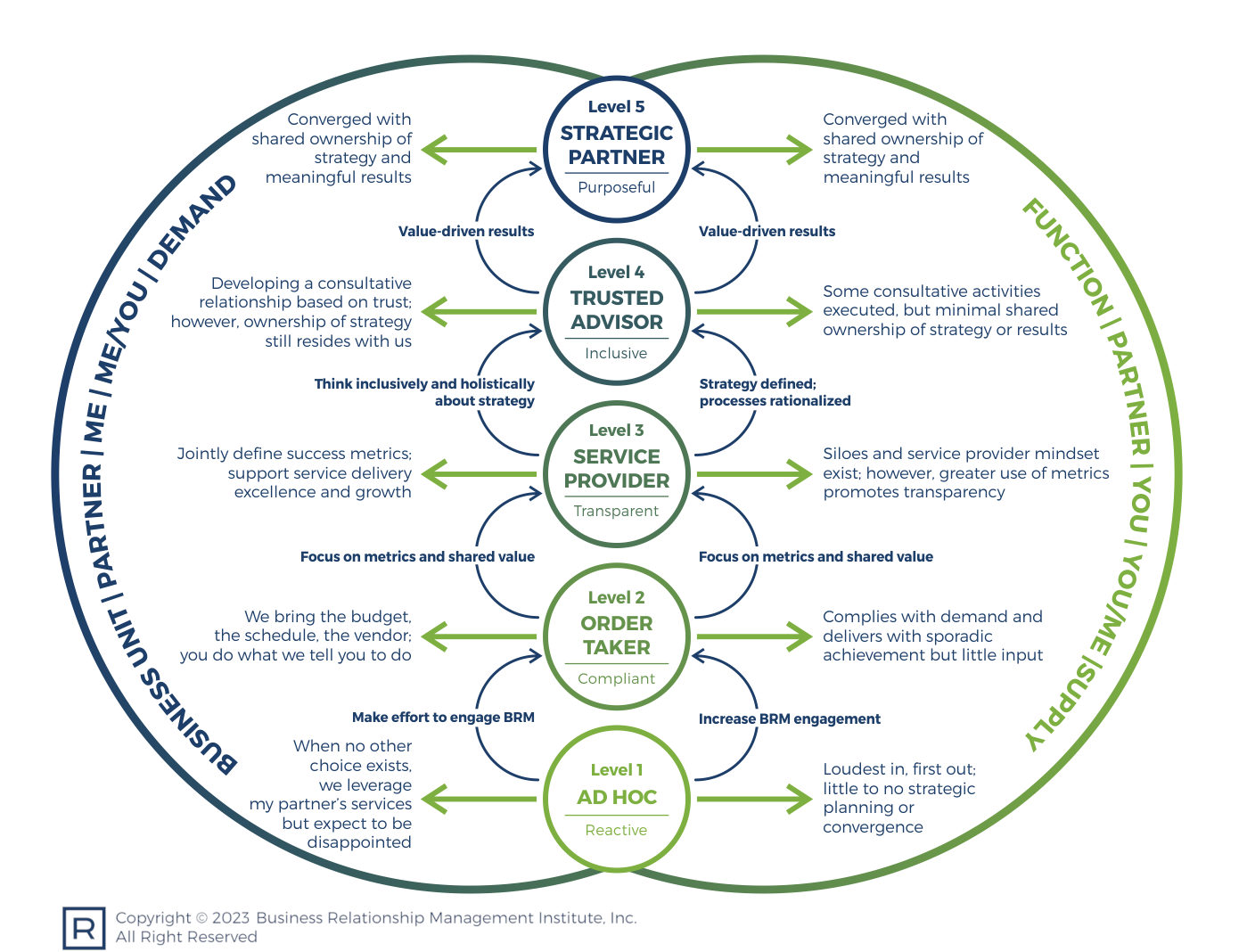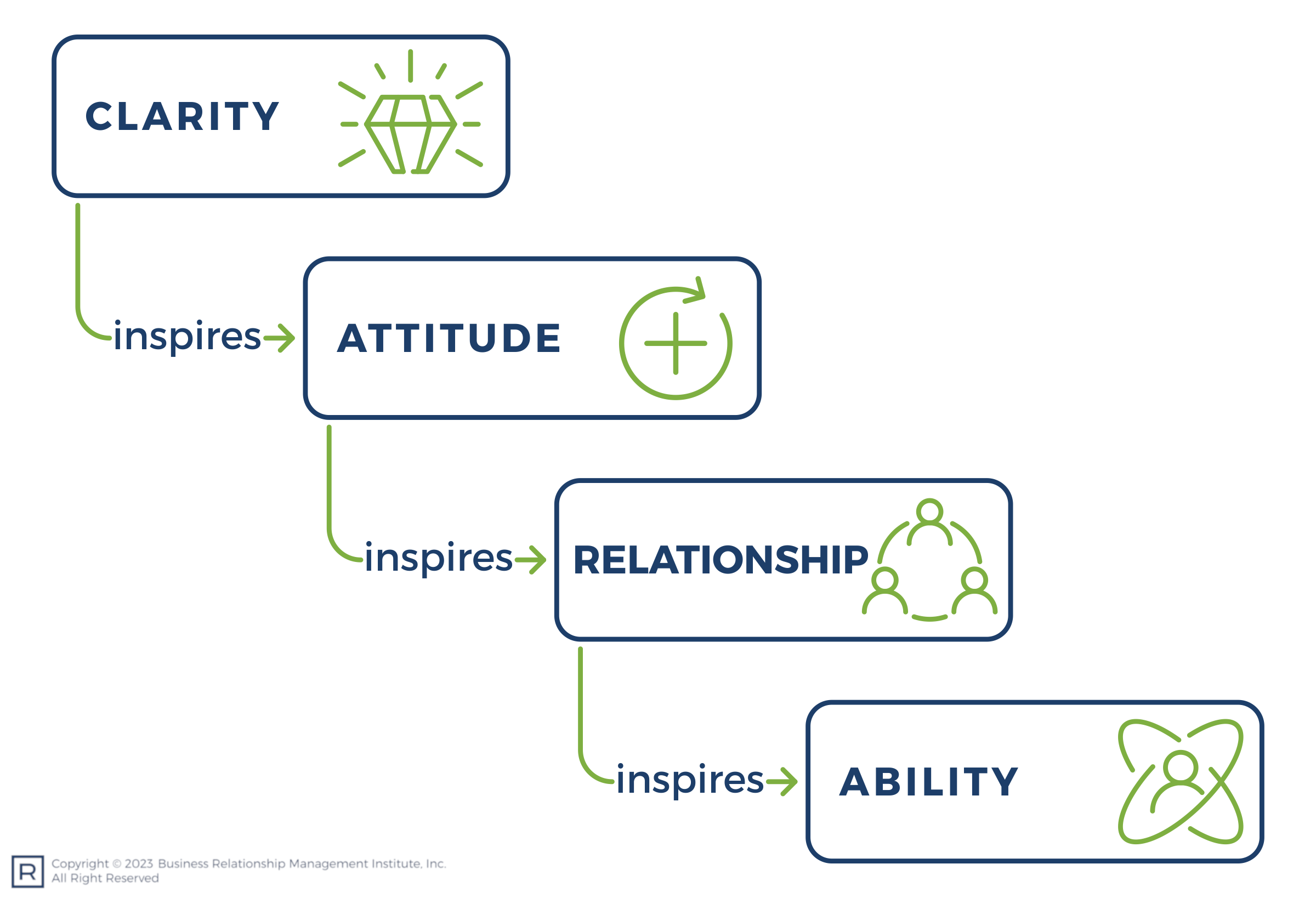Building Your BRM Capability Evolution Map: A Practical Application

BRMs often ask for a practical template for creating a specific business relationship management capability evolution map that is immediately applicable to their organization. Use the outline below to document the “what,” “how,” “who,” and estimated timeline for each of the following.
The practical application approach outlined here has been successfully utilized by a wide range of organizations, from small start-up companies to some of the largest public and private entities around the globe. Its versatility and effectiveness make it applicable across various industries, providing a robust framework that assists functions in achieving strategic partner maturity.
Whether you’re a burgeoning enterprise or a well-established organization, this approach can help you enhance your BRM capabilities and drive significant business value.
Links in this article are accessible by BRM Institute Professional Members in the Online Campus and the BRM Body of Knowledge.
Ready to become a member and access more rich content and BRM knowledge?
Click to enlarge
Building Your BRM Capability Evolution Map
Albeit in separate sections, many of the following items still relate to each other. Some items below can happen concurrently, while others should be approached sequentially. It is strongly suggested that the BRM team leads and drives the success of all of the following across the organization, assigning ownership for each item. Continuous communication is critical to success.
Setting the Goal: Establish a Top-Level Goal for Your Function (IT, HR, Finance, etc)
- Create a top-level goal
- Example: “To be a converged strategic business partner with shared ownership for business strategy and business value results, resulting in “X.” (You define the “X,” such as “business value gain.”)
- Establish credibility for the goal
- “Why should we do this?”
- Define the “how” we will accomplish this goal
- Solution: through a BRM capability
- Define the roles required to champion the goal
- Define a targeted achievement timeframe (six months, one year, two years, etc.)
- Create a compelling picture of success
Links accessible by BRM Institute Professional Members in the BRM Body of Knowledge (BRMBOK)
Defining the "How" of a BRM Capability
- Establish where you are today
- Leverage the Business Value Ability Assessments
- Document the Understanding the Future State-Current State Gap
- Evolve enterprise culture to achieve strategic partnerships
- Define the culture you want
- Define characteristics of a successful culture inspired by a BRM capability
- Identify key factors that evolve culture and behaviors through a BRM capability
- Conduct a Cultural Readiness Assessment as a collaborative exercise to generate rich information and shared understanding about your culture and its impact on value realization
- Get the branding and terminology correct
- Define BRM for your function
- Shape the behaviors of your executives and peers
Links accessible by BRM Institute Professional Members in the BRM Body of Knowledge (BRMBOK)
Convergence and Shared Ownership
-
- Establish your Sharing Ownership of Both Business Strategy and Results
- Define who owns what relationships
- Set Foundation for Level 4, Trusted Advisor in just one hour
- Baseline all relationships and measure them every six months
- The goal is to move the entire function to strategic partnership, not just BRMs
- Clearly define reporting structures
- BRMs report to business leadership and function leadership
- Establish The Importance of Effective Partner Communications
- Who, what, when, and how?
- Know the business better than business partners do
- Become very familiar with the company strategy and how it cascades to each unit within the company.
- Understand the key performance metrics and goals that the company has established
- Lead with councils
- Creativity (innovation) center
- Prioritization council
- Digital (AI) council
- Customer experience council
Links accessible by BRM Institute Professional Members in the BRM Body of Knowledge (BRMBOK)
Assess Impacts to Enabling Your Capability
-
- Change branding—stop referring to yourself as a service, as you are part of business
- Define the organizational structure
- Define the Ideation approach
- Define the value management approach
- Define new artifacts
- Build out your ROSCI Charting: Clarifying BRM Decision Rights
- Clearly define discipline interactions
- Show shared ownership (replaces RACI)
- BRMs should meet with their function’s peers regularly to build one-on-one trust
- With support from the architects, create a single mulit-year business capability roadmap that enables the business strategy
- Ensure a stable foundation to achieve strategic partnership
- Create an idea/project to stabilize current state
- Create an idea/project for “staying current”
- Requires an investment from organization
- Develop a communication plan
- Establish a platform to enable all of the above
Links accessible by BRM Institute Professional Members in the BRM Body of Knowledge (BRMBOK)
Click to enlarge
Building and Supporting the BRM Team
Your BRM Team needs support and clear understanding from all executives and major stakeholder of the creativity, innovation, and value brought to the organization through a BRM capability
Executive and Stakeholder support
- Hire the best—add BRMP/CBRM as preferred certifications in role descriptions
- Define a BRM team budget for training
- Team outings
- Conferences/BRMConnect
Business partners
- Bring outside-in perspective through meetings with end customers/consumers
- Establish a platform to house artifacts and facilitate collaboration
- Define the business analyst role and reporting structure
Solving Time Management Issues
- Focus on strategic tasks
- Are you in the right meetings? Read the book Essentialism: The Disciplined Pursuit of Less by Greg McKeown
- Work with your business function peers to own and drive success for their areas
- Don’t be a superhero- you cannot be all things to all people.
Metrics That Drive Success
- Assign BRM Metrics that Drive Behaviors Critical to Success
- Ensure consistent and standard tools are used, such as…
- Strategic Relationship Plan Template
- Maturity level model assessment
- RSOAP
- BRM SWOT Analysis—Perform line of business-level SWOT exercises with business partners to stay competitive, drive innovation, and identify weaknesses and opportunities
BRM Competency Assessment and Development
- Leverage BRM Competency Assessment and Development tools
- Ensure that Ideation and demand shaping processes exist
- Define team-level communication
- Build and follow the BRM Evolution Map
BRM Body of Knowledge links are accessible for BRM Institute Professional Members via the BRM Body of Knowledge (BRMBOK)
Build and follow the BRM Evolution Map
Click the link above to read the full playbook in the Online Campus.
Get the Playbook in the Marketplace now.
Be sure to take the time to document all of the above, including the timeline.
Continuous Improvement
-
Ensure that you have a timeline defined for all of the above
-
Define plans for business partner or BRM entry/exit
-
Consider the Cultural Readiness Assessment
-
Aggregate the Relationship Maturity Assessment and business value results by business area or value stream. Present results to CEO on a routine basis
-
Routinely assess Measuring an Organizations Business Value Ability and Cultural Readiness and report the results to the CEO
-
Establish whether your BRM capability should reach your CEO and above
By following this comprehensive BRM Capability Evolution Map, your organization can effectively evolve its BRM capabilities, ensuring a strategic partnership with shared ownership of business strategy and results.
Continuous improvement and communication are key to maintaining progress and achieving long-term goals that lead to a thriving organization.
Links in this article are accessible by BRM Institute Professional Members in the Online Campus and the BRM Body of Knowledge.
Ready to become a member and access more rich content and BRM knowledge?
If you have questions or want to learn more, contact us today!

